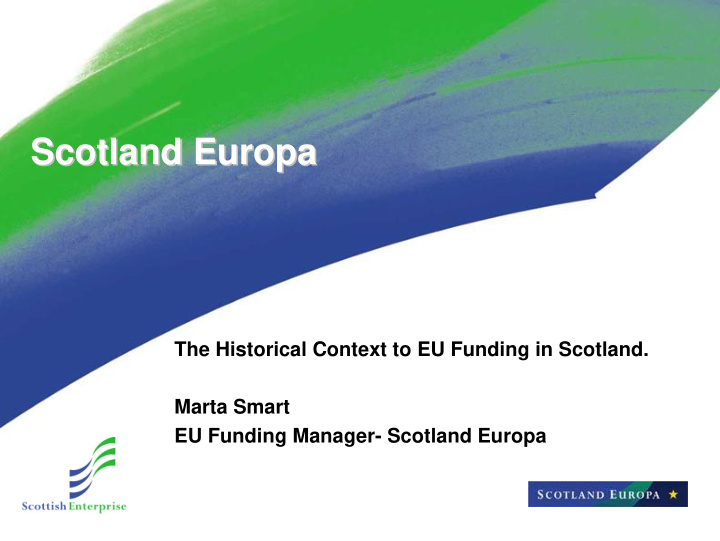



Scotland Europa Scotland Europa The Historical Context to EU Funding in Scotland. Marta Smart EU Funding Manager- Scotland Europa
Structural Funds in Scotland- A brief history � Scotland has been there from the start of European Structural Fund � It is estimated that between 1975 and 2006 £4bn in EU structural funds have been invested in Scotland. � Between 1975 and 1984 we were the third highest recipient in the EU, primarily focused on steel and ship building in the West of Scotland � Glasgow and Tayside were among the first 7 National Programmes of Community Interest approved in 1986 � An NPCI for West Lothian followed in 1987 � Strathclyde’s Integrated Development operation (IDO), the forerunner of the West of Scotland Objective 2 programme awarded in 1988
Post 1988 � The importance of regional policy grew with successive budget increases. � 1988 saw the Maastrict Treaty and major reform of structural funds. � Treaty actually cites’ economic and social cohesion as one of the pillars of the community’. � structural funds budget doubled with eligibility for assistance defined on a community wide criteria for the first time � 75% GDP per capita for Obj 1 status � labour market criteria for objective 2 and 5b. � 43.5% of community’s pop covered.
1988 Reform of the Structural Funds: priority objectives 1. promoting the development and structural adjustment of lagging regions 2. converting regions seriously affected by industrial decline 3. combating long-term unemployment 4. facilitating the occupational integration of young people 5. reforming the common agricultural policy by: (a) speeding up the adjustment of agricultural structure (b) promoting the development of rural areas
1988- - 1993 1993 1988 � Scotland secures £658m � Obj 2: WoS � EoS (Tayside, Fife, Central). � Obj 3 and 4 � H&I Objective 5b disbursed through 6 regional development programmes
1993 Revision of the Structural Funds: priority objectives 1. promoting the development and structural adjustment of lagging regions 2. converting regions seriously affected by industrial decline 3. integration of persons excluded from the labour market 4. facilitating adaptation of persons excluded from the labour market 5. reforming the common agricultural policy by: (a) speeding up the adjustment of agricultural structure (b) promoting the development of rural areas
1994- 1999 � £277m- H&I Obj 1 � £477m- Lowland and uplands over 7 programmes • Western Scotland (Objective 2) • Eastern Scotland (Objective 2) • Dumfries and Galloway (Objective 5b) • North and West Grampian (Objective 5b) • Borders (Objective 5b) • Rural Stirling/Upland Tayside (Objective 5b) • Obj 3 programme created and decentralized management to Scottish Office.
1999 Reform of the Structural Funds � By early 1990 it was clear the constant increases could not continue. � German reunification and possibility of eastern Europe new member states. � First reduction in population coverage from 52.1% to 40.2%. � Reduced objectives from 7 to 3. • 1. promoting the development and structural adjustment of lagging regions • 2. supporting economic and social conversions of areas facing structural difficulties • 3. supporting the adaptation and modernisation of policies and systems of education, training and employment. � 2000- 2006: H&I special transition Objective 1- £ 189 million.- testament to active engagement and lobbying. � Lowland and upland three Objective 2 programmes- £447 million: � Obj 3 - £300m
IMPACT � Hugely difficult to define at national and programme level: � Multiple sources of funding � Unreliable/ inconsistent monitoring data � Double counting � Cannot define what would have happened if no structural funds. � Hard to ignore impact at local/ project level. � 1994-99 H&I programme two thirds of projects stated they would not have gone ahead without structural funds. � In lowland Scotland- difficult to think of a major capital project without ERDF support � Difficult to name a voluntary sector organsiation not utilising structural funds � Difficult to name an economic development intervention that does use ERDF.
Impact � Gartcosh Ravenscraig � Glasgow Harbour Edinburgh City By-pass � Dundee Inner Ring Road Aonach Mor, Lochaber � Glasgow Royal Concert Hall � rail-line extensions at Airdrie, Cumbernauld and Paisley � New Lanark Heritage Centre � Glasgow Science centre � Business parks, ferry links and tourism facilities. � the gross aggregate employment effects of the regional programmes could be upwards of 270,000 jobs created or safeguarded over the period 1989-2006.
10.0 12.0 14.0 0.0 2.0 4.0 6.0 8.0 July 1975 January 1977 July 1978 January 1980 Scottish claimant count unemployment rate, 1955-2006 July 1981 January 1983 July 1984 (% of economically active) January 1986 July 1987 January 1989 July 1990 January 1992 July 1993 January 1995 July 1996 January 1998 July 1999 January 2001 July 2002 January 2004 July 2005
Growth in Scottish GDP, index 1975=100 180 160 140 120 100 80 1975 1977 1979 1981 1983 1985 1987 1989 1991 1993 1995 1997 1999 2001 2003 2005
Qualitative Impact � The qualitative impact of Scotland’s structural fund programmes are well recognised. � Multi annual strategic approach to economic development. � Embedding equal opportunities and environmental sustainability � The unique Scottish partnership model appears to have brought a number of specific benefits: � Strategic focus � Efficiency � Leverage � Targeting � Innovation
Negative Aspects of SFs in Scotland � Complexity � Bureaucracy � Subsidy mentality
Conclusion and questions � Scotland has been at the centre and vanguard of regional policy in Europe. � Scotland has participated in 27 programmes over 30 years. � The challenge before us must be seen in this context: � how do we use reduced funds effectively? � How will we fill the gaps? � How do we ensure a lasting legacy?
Recommend
More recommend